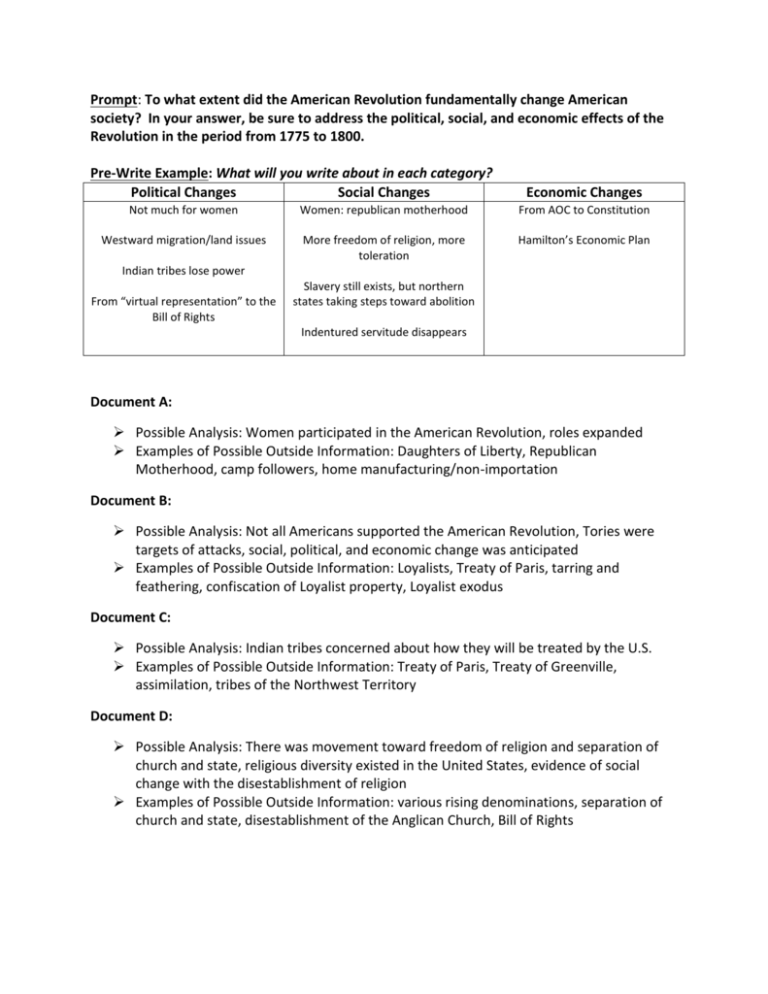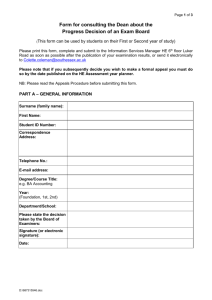Prompt: To what extent did the American Revolution fundamentally
advertisement

Prompt: To what extent did the American Revolution fundamentally change American society? In your answer, be sure to address the political, social, and economic effects of the Revolution in the period from 1775 to 1800. Pre-Write Example: What will you write about in each category? Political Changes Social Changes Economic Changes Not much for women Women: republican motherhood From AOC to Constitution Westward migration/land issues More freedom of religion, more toleration Hamilton’s Economic Plan Indian tribes lose power From “virtual representation” to the Bill of Rights Slavery still exists, but northern states taking steps toward abolition Indentured servitude disappears Document A: Possible Analysis: Women participated in the American Revolution, roles expanded Examples of Possible Outside Information: Daughters of Liberty, Republican Motherhood, camp followers, home manufacturing/non-importation Document B: Possible Analysis: Not all Americans supported the American Revolution, Tories were targets of attacks, social, political, and economic change was anticipated Examples of Possible Outside Information: Loyalists, Treaty of Paris, tarring and feathering, confiscation of Loyalist property, Loyalist exodus Document C: Possible Analysis: Indian tribes concerned about how they will be treated by the U.S. Examples of Possible Outside Information: Treaty of Paris, Treaty of Greenville, assimilation, tribes of the Northwest Territory Document D: Possible Analysis: There was movement toward freedom of religion and separation of church and state, religious diversity existed in the United States, evidence of social change with the disestablishment of religion Examples of Possible Outside Information: various rising denominations, separation of church and state, disestablishment of the Anglican Church, Bill of Rights Document E: Possible Analysis: Native Americans were not included in the making of the Treaty of Paris, Native Americans apprehensive about relations with the United States Examples of Possible Outside Information: Treaty of Paris, Treaty of Greenville, assimilation, tribes in Northwest Territory Document F: Possible Analysis: United States was predominantly an agricultural society of small farmers, there was controversy over the economic future of the United States (agricultural vs. manufacturing), supports the Jeffersonian notion of agrarian republicanism based on independent farmers Examples of Possible Outside Information: Jefferson vs. Hamilton (agriculture vs. commerce) Document G: Possible Analysis: There was serious unrest in areas of the U.S., common people can be easily won over to radical causes, Shays’ Rebellion was in progress, government might not be strong enough to suppress rebellion and guarantee stability Examples of Possible Outside Information: “remember the ladies”, decline in value of currency, Shays Rebellion, Whiskey Rebellion, Hamilton’s economic plan, weaknesses of AOC Document H: Possible Analysis: white settlers moving West, opposition to slavery growing in the North, a system of government was devised for the new territories Examples of Possible Outside Information: Northwest Ordinance, system of survey, three-fifths compromise, potential conflict between Indians and settlers Document I: Possible Analysis: fear of government having too little power, checks on both government and the people are needed, Madison supported ratification Examples of Possible Outside Information: Constitution, separation of powers, checks and balances, Bill of Rights, Federalists vs. Anti-Federalists, First Party System Document J: Possible Analysis: increased discussion of educational opportunities for women, women begin to challenge the notion of separate spheres, (juxtapose with Doc A to demonstrate failure of anticipated changes to materialize) Possible Outside Information: Benjamin Rush, Republican Motherhood, Judith Sargent Murray Pre-Write (continued): Where will each document be used? Political Changes Social Changes Economic Changes Doc B: Tories Doc C: Native Americans Doc E: Native Americans Doc G: Rebellion vs. Stability Doc H: Western Expansion/Slavery Doc I: Checks and Balances Doc A: Women Doc D: Religion Doc J: Women and Education Doc F: Jefferson vs. Hamilton (maybe Doc G: currency) (In the essay you can juxtapose documents – to use side by side – if you want to). Contextualization Example: Tensions between Britain and the American colonies had been rising since the end of the French and Indian War in 1763. Years of bickering over taxation policies and the meaning of liberty resulted in America’s Declaration of Independence and the American Revolution. Synthesis Example: The American Revolution set a precedent for a unique American system of politics and culture that would eventually influence the French Revolution and other campaigns for independence around the world. Modeling How To Use Documents AND have Outside Information Analysis (starting with the 1st paragraph after the thesis statement paragraph): The American Revolution prompted new debates in women’s roles and rights. Women were seen as having important roles throughout the revolution (Doc A). Because she is labeled as a patriot, she is a symbol of women taking a role in fighting for liberty. The purpose of this document is to display women’s changing roles in society. Before the Revolutionary War, women were viewed as not being able to do much, as only playing a subordinate role in family and societal matters. After the Revolution, although there was not much change regarding women’s political rights, there were more discussions about expanding educational opportunities and women’s roles in society in general (Doc J). The point of view is an example of the ideology of “republican motherhood” that emerged as a result of independence, of the idea that women played an indispensable role by training future citizens. Indeed, women began to argue for new political rights, but there was not as much emphasis on this issue when compared to women’s educational opportunities.





